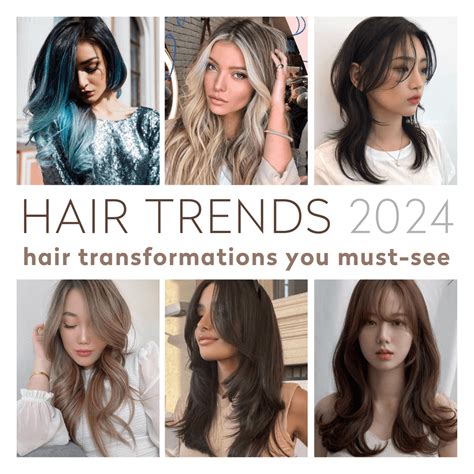Hair Color Revolution: Unveiling the Best Hues for Every Taste
Introduction

Hair color has emerged as a transformative tool that empowers individuals to express their styles, personalities, and creativity. With countless options available in the realm of hair dyes, it can be daunting to choose the most flattering and on-trend shades. This comprehensive article delves into the latest hair color trends, providing expert insights, helpful tips, and inspiration to guide you towards your dream hair transformation.
Top 7 Hair Color Trends to Turn Heads
-
Opulent Copper: Embracing warmth and radiance, copper hues have surged in popularity. From vibrant auburn to soft rose gold, this versatile color enhances all skin tones, adding a touch of allure and sophistication.
-
Versatile Brunette: Brunette shades continue to dominate, offering a spectrum of options from rich espresso to light chocolate. Whether you prefer cool or warm undertones, brunette hair enhances natural features while providing endless styling possibilities.
-
Refined Platinum Blonde: Platinum blonde exudes elegance and a modern edge. Achieving this icy hue requires specialized techniques and professional expertise, but the results are worth the effort. It complements fair skin tones and brightens the complexion.
-
Dimensional Balayage: Balayage involves hand-painting hair to create seamless transitions between shades. This technique delivers a natural, sun-kissed effect that adds depth and movement to your locks.
-
Bold Vivids: For those seeking a statement-making look, vivid hair colors such as electric blue, vibrant green, or ethereal purple demand attention. These hues require regular maintenance to preserve their vibrancy.
-
Pastel Perfection: Pastel hair colors add a whimsical and ethereal touch to any style. Soft hues like lavender, baby pink, or mint green are ideal for those who want to experiment with color without making a drastic change.
-
Subtle Ombre: Ombre transitions gradually from one color to another, creating a multidimensional effect. This trend allows you to blend complementary shades, adding depth and dimension to your hair.
The Importance of Professional Coloration
While at-home hair coloring may seem convenient, entrusting a professional colorist is highly advisable. Skilled hair stylists possess the knowledge and experience to assess your hair type, skin tone, and desired outcome, ensuring you achieve the perfect shade while maintaining hair health.
Choosing the Perfect Shade for Your Skin Tone
-
Cool Skin Tones: Shades with ash, violet, or blue undertones, such as platinum blonde, ashy brunette, or icy rose gold, complement cool skin tones.
-
Warm Skin Tones: Shades with golden, copper, or red undertones, such as caramel blonde, warm brunette, or strawberry blonde, enhance warm skin tones.
-
Neutral Skin Tones: Neutral skin tones have a balance of both cool and warm undertones, allowing for a wider range of hair color options.
Common Mistakes to Avoid
-
Over-processing: Excessive use of bleach or hair dye can damage hair, resulting in breakage and dryness.
-
Improper Home Coloring: Attempting complex hair coloring techniques at home without professional guidance can lead to uneven or undesirable results.
-
Ignoring Hair Health: Prioritize hair health by using color-safe shampoos and conditioners, deep conditioning regularly, and minimizing the use of heat styling tools.
Pros and Cons of Hair Coloring
Pros:
-
Express Individuality: Hair color provides a unique opportunity to reflect your personality and style.
-
Enhances Features: The right hair color can accentuate your eyes, skin tone, and overall appearance.
-
Camouflages Gray Hair: Hair coloring effectively conceals gray hair, restoring a youthful and vibrant look.
Cons:
-
Hair Damage: Chemical hair coloring can potentially damage hair if not performed correctly or overused.
-
Maintenance: Colored hair requires regular touch-ups to maintain vibrancy and prevent fading.
-
Allergic Reactions: A small percentage of individuals may experience allergic reactions to hair dyes.
Innovation in Hair Color Technology
The hair color industry is constantly evolving, introducing innovative technologies to enhance the coloring process.
-
Ammonia-Free Dyes: Ammonia-free hair dyes minimize irritation and damage, offering a gentler alternative to traditional hair dyes.
-
Semi-Permanent and Demi-Permanent Dyes: These dyes provide a less permanent color change, allowing for experimentation without the commitment of permanent dyes.
-
Bio-Based Hair Dyes: Plant-derived and other natural ingredients are used in bio-based hair dyes to reduce the environmental impact of hair coloring.
-
Hair Color Enhancing Apps: Virtual hair color apps allow you to visualize different shades on your own hair, providing a helpful tool for decision-making.
Conclusion
Hair color holds the transformative power to elevate your personal style and express your inner creativity. By embracing the latest trends, consulting with professional stylists, and choosing shades that complement your skin tone, you can achieve a hair color that turns heads and enhances your overall appearance. Embrace the hair color revolution and embark on a journey of self-expression through the art of hair coloration.
